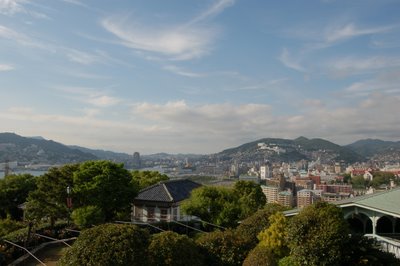It was in Kyushu that Japan first made contact with the western world. Some shipwrecked Portugese washed ashore, and quickly set up trading links all over the island. Worried about increasing foreign activity and the influence of Catholicism, all foreign trade was soon restricted to Nagasaiki. Soon after the Portugese were confined on a small artifical island in the bay, Dejima.

Soon thereafter the Portugese and their meddling Jesuit friends were expelled, and an exclusive trade agreement was struck with the Protestant Dutch, who were seen as interested only in trade, and not in conversion. They took over Dejima, and it became the sole avenue for Western trade, philosophy, and science for over two hundred years, from 1641 to 1854 when Perry forcibly opened Japan to the West.

Well to a history buff like me, a visit to Dejima was mandatory! The actual island had long since been enveloped by harbor reclaimation, but is rapidly being restored to its early 19th century form. The faithfully rebuilt structures had some fascinating displays on the history of Japan and its contact with the west. Included in the displays were a series of ship models showcasing the nations and time periods involved in the Dejima trade. One of them, pictured above, is the ship that brought William Adams, the English sailor whose life was fictionalized in Shogun, to Japan. The displays were all quite good, and almost everything was bilingual too, which is always a plus. Of course the rumbling honking trams going by every five minutes did tend to pull you out of the whole 1800's "vibe."

Our next stop was the Nagasaki Atomic Bomb Museum in the northern suburb of Urakami. It was a sobering yet interesting stop. I will admit though that I liked the Hiroshima museum better as it seemed a bit more even handed, presenting the why of the bombing and the military reasons for targeting the city. The Nagasaki Museum pretty much just featured photo after photo of devestated schools and burned children. Which given that there were hundreds of high school kids walking around us made me fear a bit for my safety! Well not really, actually to them we were like rockstars, with lots of pointing and giggling.

Next stop was a conbini lunch in Hypocenter Park, the exact place above which 'Fat Man' exploded. It was a nice park, with statues and memorials, and a section of the blasted wall of Urakami Cathedral. Ironically enough, overlooking the park is a couple of love hotels, which is rather strange to say the least. I suppose its the ultimate "make love not war" statement.

After dropping off a tired Liz at the Holiday Inn, I treked towards China Town and the Glover Slope. Nagasaki was the point of contact for ALL (legitimate) foreign trade, and that includes Chinese trade. While the Chinese merchents were less restricted than the Dutch, they did have their own quarter and were technically not allowed outside. This lead to a nice little modern China Town, packed with dim sum restaurants and interesting shops.

On towards the South end of town is the Glover Garden, an area that is also tied into Nagasaki's history of foreign trade. After the Meiji restoration and the opening of Japan fully to western trade, Nagasaki of course became one of the major port cities. This lead to a thriving ex-pat community, and some of the nicer houses and landmarks from that have been assembled along the pleasant landscapes of the Glover Garden. The area is named after one of the more important personages of Meiji Era Japan, one Thomas Blake Glover. Ironically this is another link to James Clavell, as Glover started his career working in Nagasaki for Jardine Matheson, the trading company fictionalized as Struans in Tai-pan and Noble House. Glover eventually started his own company, and had a profound effect in Japan doing things like bringing the first steam engine and dry dock to Japan. And so the houses of him and his collegues form a great little tourist attraction! The houses were interesting enough, but the view of Nagasaki and the harbor were what really justified the price of admission.

After a quick dinner at MOS Burger with Liz, I headed out for a date with the sunset. I had seen a photo taken from the top of a nearby mountain, and I just had to get my tripod and camera up there for some low light photography...
To Be Continued!

3 comments:
Wow. That actually looks ... awesome, especially Chinatown and Dejima. Nice to hear that it's being restored. Heck, they're even starting to deconcrete the coastline for sea turtles somewhere in Aichi! Perhaps there is hope yet!
Sometimes I really hate living all the way up here. I want to go see Nagasaki now ...
Mike from Japan Is Doomed here, just dropping by to see how my favourite writer is doing :) I loved the photo of Hypocenter park and especially the view from Glover Garden...inspiring! :)
Interesting entry. I like the lesson in history and letting us readers of James Clavell know the tie ins from fiction with the reality. Thanks!
Post a Comment